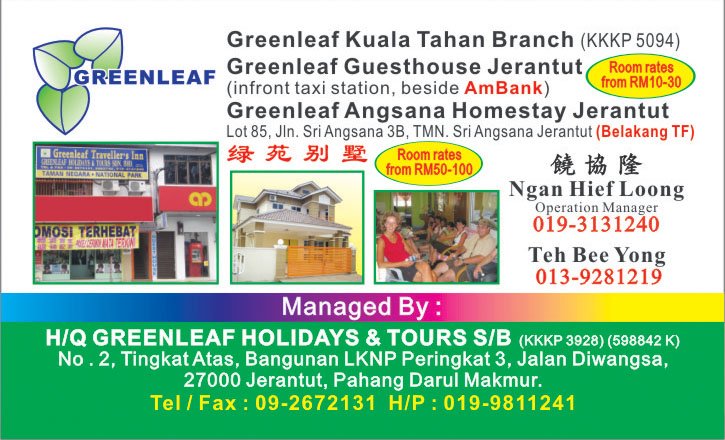Main Menu
Visitors Counter








 | Today Visitor | 254 |
 | Total Visitor | 1028004 |
| About Jerantut |
|
The area of Jerantut District covers 7,563 km per sq ft (7563 hectares), boundering the northern states of Kelantan and Terengganu, in the south, Temerloh and Maran district, in the west, Lipis and Raub district and in the east, Kuantan district. The population in Jerantut district is approximately 83,699 in 125 villages in 10 sub-districts. The large portion of land appears to be forested which forms from Permanent Forest land (387,917 hectares) and National Park (188,206 hectares). The segmented use of other lands are FELDA (57,962 hectares), State land (52,162 hectares), Titled lands (45,322 hectares), Clustered (7,585 hectares), Private estates (6,394 hectares), LKPP (5,792 hectares), FELCRA (3,792 hectares) and RISDA (1,214 hectares). Agricultural sector makes up the main activity in this district contributing KDNK (1994) as much as 53%, tourism sector shows a rapid development with the existing world class tourism like National Park and a few new tourism locations like Lembah Kiol Golf Course, Lata Meraung waterfall, Jeram Perahu, Kota Gelanggi Cave, Tekam Plantation Eco Resort and so on. Tembeling River, the main river in this district is the exciting way to National Park and the surrounding villages in Ulu Tembeling. The joining of Tembeling and Jelai river forms the Pahang river where it flows right through the Royal Pekan town and then through the South China Sea. The Central district administration in Jerantut town is situated 200km away from Kuantan or 250km away from Kuala Lumpur. This town is the main gate to National Park which is linked by roads, trains and boats. Jerantut is the largest district in Pahang state and also a progressive town, like any other town in Malaysia today, with new mixed property developments having been built and a beautiful mosque just built on the approach to the town.
It may be hot and humid throughout the year in Jerantut with temperatures ranging from 21 Celsius to 34 Celsius. There are also rainy period, but this should not put a damper on you, as you are assured of plenty of sunshine. The rainy seasons, caused by the monsoons usually occur between November to February along the east coast of the Peninsular, while the west coast has its rainy season between August and September. Annual rainfall can be as high as 2,500 mm.
At most Malaysian can speak, read and/or write at least two languages, thus communicating with them poses no problems. English is commonly used and spoken throughout the country. It remains the language of commerce, banking and international trade. Tourists with even a basic understanding of English will have no difficulty in getting around the country. The national language is of course Bahasa Malaysia or more commonly known as Malay. It is widely used by Malaysians in their daily life and even in business. The other common languages spoken in the country are Mandarin and Tamil, although several dialects are still in use.
The unit of currency is the Malaysian Ringgit indicated (RM) which is equivalent to 100 sen. Coins are issued in the denominations of 1 sen, 5 sen, 10 sen, 20 sen and 50 sen. Currency notes are in RM1, RM2, RM5, RM10, RM50 and RM100. Foreign currency and travelers cheques can be converted to Malaysian Ringgit at banks or authorized money changers throughout the country.
|
|
Contact Us at:
Email: info@tamannegara.my |
  |
|













